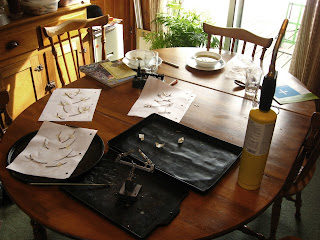The title's a bit of a misnomer since I did not do it entirely myself, but if you know how to weld or someone who does, you're good.
The aforementioned train-track-camera-rig wasn't going to cut it for this stop-mo project, so I picked up the phone and called home. My dad is an amazing handyman and knows how to weld (bonus!), so we sat down and made a plan for a do-it-yourself camera rig, one that would be relatively portable, stable, and cost-effective, with the ability to tilt the camera at different angles as well as do horizontal panning. The plans drew up something like this:
And the final outcome was this beaut:
The base is a chair bottom from one of my mom's old sewing chairs - having a pack-rat streak in the family is very convenient. The vertical pipe is fence-rail, the horizontal one a big square length of steel pipe. My dad welded together larger square and round pipe sections for the adjusting piece that allows the camera to be moved along the dolly, as well as nuts onto each piece and steel handles onto bolts in order to lock the pipes in place. A special thank you to
Mitchel Kennedy for the suggestion of using a tripod head to mount the camera on the rig - the stand that attaches to the head fits nicely into the square pipe and allows for up-down swivel. We added a nut and bolt at that end to lock it into place.
Did some tests with it, made some adjustments, and overall it worked out pretty well. The vertical pipe slides onto a piece of metal scrunched into the top of the chair base - it can wobble a bit, so I drilled a hole and stuck in a long screw, which worked for the time being. What it really needs is two screws going all the way through at different angles to hold it in place, which will be done before next use. There's some wiggle within the horizontal track, which changes depending on how far or close the camera is to the centre and the distribution of its weight, which isn't difficult to correct mid-shot. You learn its little quirks and work with them. Overall pretty awesome for a home-made project. I am extremely grateful for the help with this.
I also made an old turntable into a simple rig for a panorama-type shot, removing the rubber mat, elastic band (which was already shot I think when I got it), needle arm etc. and using measuring tape for marking increments.







.jpg)













































